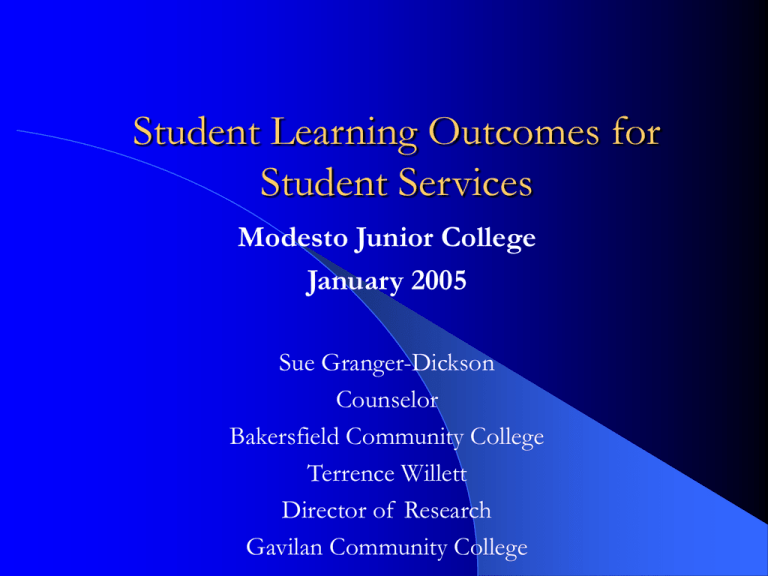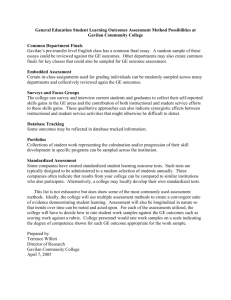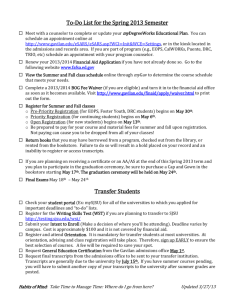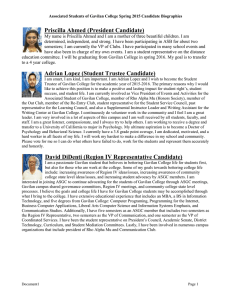Student Learning Outcomes
advertisement

Student Learning Outcomes for Student Services Modesto Junior College January 2005 Sue Granger-Dickson Counselor Bakersfield Community College Terrence Willett Director of Research Gavilan Community College Learning Outcomes for Today Summarize history of accountability and how new standards came to be Define learning outcomes and explain the underlying philosophy Describe the assessment cycle and its role in the college Write appropriate student learning outcomes for your program Explain at least two methods to assess at least one student learning outcome including needed resources and potential barriers Identify at least 3 resources to help you succeed in the learning outcomes challenge Your expectations and needs 1960’s History – In the past, year-end reports demonstrated proper management but not whether the programs directly aided student learning – Colleges measured enrollments, participation rates, budget expenditures 1990’s – More recently have expanded to measure success, retention, persistence, graduation, and transfer – Focus has also been on instructional delivery versus student learning 2000’s – Student Learning Outcomes Present state of MJC Standard IIB The institution recruits and admits diverse students who are able to benefit from its programs, consistent with its mission. Student support services address the identified needs of students and create a supportive learning environment. The entire student pathway through the institutional experience is characterized by a concern for student access, progress, learning, and success. The institution systematically assesses student support services using student learning outcomes, faculty and staff input, and other appropriate measures in order to improve the effectiveness of these services. What are Learning Outcomes? “Learning outcomes” not a new concept – Used in California in K-12, special ed, voc programs – Used in other college systems (i.e. Maryland, England) – Barr and Tagg called for learning outcomes in 1995 Focuses more on students’ learning rather than just how we instruct or support them; outcome based Emphasis on higher more complex level of learning Clearly states educational intentions for students See example SLO in Appendix E in handout Sounds like behavioral objectives! Learning outcomes differ from behavioral objectives by – Being broadly stated – Having instructors assess gains in skills rather than creating detailed list of specific topics and abilities to be mastered (Harden 2002) Some authors do not perceive that the difference between learning outcomes and behavioral objectives is important (Prideaux 2000) Important to distinguish the two to gain acceptance 6 Principles – O’Banion The Learning College… …creates substantive change in individual learners …engages learners in the learning process as full partners who must assume primary responsibility for their own choices …creates and offers as many options for learning as possible …assists learners to form and participate in collaborative learning activities …defines the roles of learning facilitators in response to the needs of the learners …succeeds only when improved and expanded learning can be documented for learners Levels of Analysis Institutional Department or Program Class or Service Assignment or Student Interaction New Perspective “We must treat the college as a learning laboratory” – John Baker, VP SS Gavilan Dealing with whole student-their uncertainty, response to that uncertainty, and their wisdom and courage-all matters of being (Harden 2002) Shift from instruction as “core of the college” towards learning as central focus True marriage between academic and life skills learning Institutional Concerns Students have a fundamental right to services and if these services are not or cannot be related to learning outcomes, their existence could be unfairly jeopardized (Collins 2002) Uncritical application of business models and concepts to education Fear all this measuring will be a waste of effort and not enhance student achievement – Luna, Gavilan College Academic Senate Do students really care about learning? - Borden Assessment at Bakersfield College 2001-Outside audit-impetus to become a learning college 2002-Program & Budget review transformed into IEC 2002-Faculty sent for training July, 2002-New accreditation standards BC Assessment continued… 2003-Campus wide audit – Development of mission statement – Description of how they IMPROVE student learning – Opening Day workshop-each faculty member write one SLO BC Assessment continued… 2003-Campus-wide cross disciplinary instruction workshops on writing SLO’s Academic Senates adopts assessment as one of its goals – Philosophy statement developed – Creation of assessment plan at AAHE – Interviews of 41 concerned faculty members BC Assessment continued… 2004-Student services SLO Workshops General Education Committee adopts draft SLO’s Critical Thinking Committee adopts draft SLO’s Assessment coordinator selected with reassigned time Gavilan’s Approach Discussion began in Student Services Had SLO presentations at convocation and meetings of department and program leads as well as attending external workshops Institutional learning outcomes selected Course level learning outcomes written Currently developing program level outcomes Next steps include publishing outcomes in catalog and implementing assessment of outcomes Gavilan Institutional Learning Outcomes (from Palomar College) Communication Cognition Information Competency Social Interactions Aesthetic Responsiveness Personal Development and Responsibility Gavilan Institutional Learning Outcomes Communication – Listening – Reading – Writing Gavilan Instutional Learning Outcomes Cognition – Analysis & Synthesis – Problem Solving – Creative Thinking – Quantitative Reasoning – Transfer of Knowledge & Skills to a New Context Gavilan Instutional Learning Outcomes Information Competency – Research – Technological Gavilan Instutional Learning Outcomes Social Interaction – Teamwork – Effective Citizenship Gavilan Instutional Learning Outcomes Aesthetic Responsiveness – Differentiate between people who can sing and people who can’t e.g. Brittney Spears vs. Norah Jones – Distinguish between art that offends you, art that is cheesy, art you can’t understand, and art that is too expensive Gavilan Instutional Learning Outcomes Personal Development and Responsibility – Students will develop individual responsibility, personal integrity, and respect for diverse people and cultures – Self-management: Students will demonstrate habits of intellectual exploration, personal responsibility and physical well being – Ethics and Values: Students will demonstrate an understanding of ethical issues that will enhance their capacity for making sound judgments and decisions – Respect for Diverse People and Cultures: Students will respect and work with diverse people including those with different cultural and linguistic backgrounds and different abilities Service → Learning Outcome ↓ Counseling Student understanding and explaining Communication goals/plans; use advice from counselor Understand GE Cognition patterns; Develop ed plan Information Competency Social Interaction Financial Aid Admissions and Records Student discussing Student explaining what and understanding is desired: registering, requirements with staff transcripts, adding, etc. Calculating income, need, and unit loads Calculating units and fees Using web to gather Comprehension of Comprehension of forms program information forms and instructions and instructions Working with college Working with college Working with college personnel personnel/mentoring personnel/mentoring Form design, catalog, Aesthetic Form design, web Form design, web schedule web pages Responsiveness page layout page layout layout Personal Understand concept Provide accurate Provide accurate Development of balancing school, information; meet information; meet And work, and family deadlines deadlines Responsibility Opportunities for Student Services Support students in taking more responsibility for their own learning = framework for action (Barr and Tagg 1995) Acknowledges that Student Services personnel are also educators Your Turn! Think of an instance you directly observed a student learning while interacting with your program or service outside of a classroom experience Write a mission statement for your program or service Writing Learning Outcomes Should be based on our mission and values In an environment that nurtures creativity and intellectual curiosity, Gavilan College serves the community by providing a high quality learning experience which prepares students for transfer, technical and public service careers, life-long learning, and participation in a diverse global society Writing Learning Outcomes Outcomes must be observable so you can measure or record them Course level learning outcomes sound like behavioral objectives (or really are the same) but LO tie into institutional learning outcomes Keep in mind that outcomes are tools to guide evidence collection for assessment Assessment Cycle Create or Modify Goals and Outcomes Evaluate Implement Programs or Strategies Draft BC Assessment Plan Closing the Loop Develop, modify, or review a curriculum, course/program. Determine refinements based on outcomes data. Develop Student Learning Outcomes Closing the Assessment Loop Collect, discuss, and analyze data. Design & Measure Student Learning as a result of the Curriculum, Course, or Program Dimensions of Evidence Quantitative or qualitative – Not everything that can be counted counts and not everything that counts can be counted -Einstein Direct or indirect Norm- or criterion-referenced Should be representative and relevant Need several pieces of evidence to point to a conclusion – e.g. Student complains of fever and aches, their temperature is 102º F, tonsils are not inflamed, eyes are red and irritated, posture appears weak. Notice mix of types of evidence that all point to same conclusion…flu! Common Assessment Methods Tests – Locally developed or Standardized Performances – Recital, Presentation, or Demonstration Cumulative – Portfolios, Capstone Projects Surveys – Attitudes and perceptions of students, staff, employers Database Tracked Academic Behavior – Grades, Graduation, Lab Usage, Persistence Embedded Assessment – Using grading process to measure ILO Narrative – Staff and student journals, interviews, focus groups Example Method Strength of Evidence Randomly assign students to service Can claim causality Denies access to a service Ethical that may or Consideration may not be effective for some students Randomly Correlate use assign with students to performance receive or skills information measures about services Causality cannot be claimed, Weaker useful in causality claim conjunction with other information All students have access but some receive less information Surveys Causality cannot be claimed, useful in conjunction with other information Use student No restriction time to of access or complete information survey Case study and journals Causality cannot be claimed but complex and difficult to measure effects can be noted Confidentiality Embedded Assessment Example Criteria Joe Jane Liam Celeste Avg Arithmetic with fractions 3 4 5 4 4 Calculating basic areas 3 4 3 5 3.75 Order of operations 3 4 5 5 4.25 Right triangles 3 4 4 4 3.75 Total 12 16 17 18 Student Grade C B B A Down for grades, across for outcomes assessment –after Nichols Assessment Tips Collect data from a representative sample rather than everyone in population Collect only a few well chosen pieces of data Have assessment stem from activities you already do if possible Team up with others to share assessment work Design activities and outcomes with assessment in mind Ask for advice from your colleagues - especially vocational faculty who relate to learning outcomes as core competencies Writing Learning Outcomes Good verbs (Blooms’ Taxonomy): – – – – – – – Compile Analyze Design Apply Demonstrate Explain Compare Classify Operate Write Calculate Compose Assess Critique Bad verbs – Know Arrange Identify Solve Differentiate Formulate Predict Estimate Understand Appreciate Learn Good verbs are clear and observable, bad verbs are vague states of mind Example Learning Outcomes at program/service level Disabled Student Services – The student will be able to explain his/her individual academic strengths and weaknesses Maryland Health Education – Students will demonstrate an understanding of health promotion and disease prevention concepts to establish a foundation for leading healthy, productive lives. Admissions and Records – Students can “work the system” – Demonstrate patience while waiting in line More Student Service Examples From Ventura College SLO Workshop – DSPS = Students will demonstrate self-advocacy skills with instructors and staff – EOPS = Student will identify and describe resources available on the campus. – Counseling = Student will be able to state informed academic goal(s). – Financial Aid = Faculty and staff will be able to describe basic aspects of financial aid available to students and how students can apply for financial aid. Gavilan Counseling SLO’s Students will identify college resources, procedures, and policies that support their academic success. (Cognition) – Students will complete the college orientation and score at least an 80% on the orientation quiz. Students will use technology to gather, process, and articulate career options and choices. (Info Comp) – Students referred to the Eureka system (online/center) will complete the assessments and discuss outcomes with counselor. (track completion on SARS) – Students enrolled in Guidance 1 will utilize the internet for research and declare a major at the end of the course. Instructional Program Level SLO Examples Sinclair College – Math = Apply mathematical models to real world problems – Amer. Gov. = Communicate the significance of facts, concepts, and ideas in spoken and written English, which is clear, precise, and logical – ECE = Demonstrate professionalism in the child care setting More Instructional PSLO Parkland Community College – English = Students will create college-level written text for multiple purposes and diverse audiences that demonstrate depth of critical thought and that observe the conventions of standard written English. – Psychology = Our students will apply major theoretical perspectives and methodological approaches used in the discipline of psychology to particular social phenomena or autobiographical circumstances. Your Turn! Write at least 2 learning outcomes for your program and at least 2 assessment strategies for each outcome Reflect on Your SLO’s: Will the student understand? Is this truly an overarching outcome? Can you blend? Does this take into consideration the other areas your program interfaces with? If you had only 6 outcomes for your program, is this one of them? In reality, can this be done? Questions to Contemplate Why should I use student learning outcomes for evaluating my program? What are some strategies for writing effective learning outcomes? What are some differences between qualitative and a quantitative measurements? How can anecdotal reports or case studies be used in program assessment? What are the pros and cons of using sampling methods for assessment? Remember: Everyone is a learner when it comes to assessment Creating Venues for Dialogue Invite outside speakers Use department/committee meetings Hold lunch meetings Send people for training to create champions Hold cross disciplinary workshops Conduct campus-wide workshops Acknowledgements Gavilan Student Services Division especially: – John Baker, Margery Regalado, Jane Maringer Gavilan Instructional Division especially: – – – – Marty Johnson Marlene Dwyer & her Curriculum Committee Department Chairs Academic Senate, Enrique Luna Research and Planning Group especially: – Harriett Robles, Brad Philips, Fred Trapp, Bob Gabriner, Jerry Rudman WASC – Darlene Pacheco, Barbara Beno Thank You





